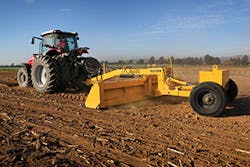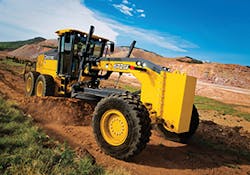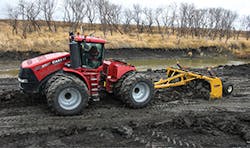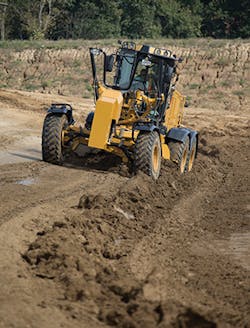Given the advances in graders, contractors are bringing them in much sooner on projects, notes Luke Kurth, product marketing manager, motor graders, John Deere.
“From a power, size, and capability standpoint, you’re seeing a lot more full utilization of the grader throughout the job site. It’s no longer purely a support machine off to the side that you grab when you need it,” he adds. “It can be utilized all the way from the beginning portion of the job to the highly accurate base materials to cleaning up at the end.”
Newer features and built-in technologies allow contractors to do tasks with graders in such a way that can “minimize overhead with fuel, the labor on the ground to get to those grades, and get the job done that much faster than in the past,” points out Kurth.
Be it a motor grader or pull-type grader, advances in the technology offer contractors advantages in the field.
Graders have independent tools with their own motor and drive system, points out Victor Hood, general manager, Garfield Equipment, adding that they have historically been used for site prep, road maintenance, and road building.
A grader is a versatile tool that can be used far beyond the typical finish grading work, notes Eric Kohout, Caterpillar product application specialist.
Among the jobs on which contractors are using graders: completing logging road construction, haul road construction, ditch cutting and ditch maintenance, oil pad construction and maintenance, snow removal, maintaining haul roads, spreading fill and aggregate base, mixing material for optimum moisture, ripping or scarifying to loosen material, cutting rough grade, and finish grading.
There are two main end-user bases utilizing motor graders and two main sets of jobs for which they are used, notes Kurth.
One is the local, state, and federal government sector that utilizes them for maintaining dirt and gravel secondary roads, reclaiming waterways, ditch work, and, to a great extent in Colorado and Canada, they are heavily used in snowplowing, he adds.
Contractors comprise the other group who use graders for site development, road building, and base material preparation. Graders also are a common sight on oil fields, where they prepare the roads leading to and from the fields but also the pads upon which the derricks are placed, says Kurth.
Moving dirt with a John Deere 672GP
They also are found in mining for quarry applications—“even underground, where contractors use them to maintain the roads in the mine itself,” adds Kurth.
The significant number of attachments that graders can now accommodate on the front, middle, and rear of the machines gives them a great deal of flexibility on the job site, says Kurth.
Graders have traditionally been the most complex piece of earthmoving equipment on the job site to operate, offering blade angling dynamics and precision accuracy, points out Shane Kroeker, vice president marketing, K-Tec Earthmovers.
“The grader operator is highly skilled and the job isn’t finished until the grader operator says it is completed to the proper specification,” he adds.
Kroeker contends that traditional motor grader equipment is expensive and delicate to maintain, adding that he believes it is best to keep the traditional motor grader in areas of extreme finish precision to maximize the value of the higher-paid operator and minimize the machine’s exposure to rougher job environments for costly maintenance repair bills.
An entry-level operator will have better performance operating a pull grader in contrast to a motor grader, says Kroeker.
Pull grader levelers are ideal on earthmoving job sites for smoothing and maintaining haul roads, he says.
“Pull graders—commonly referred to as land levelers or land planes—are ideally fitted with GPS machine control and can even compete with motor graders in performing some finish grading tasks in most scenarios,” notes Kroeker.
No matter the type, graders are now being used for tasks they weren’t traditionally meant to do.
Contractors are looking for opportunities and are getting increased utilization of the grader by using the grader to perform tasks versus bringing in another machine, such as adding a front blade or other attachments, notes Kohout.
“We’ve seen a variety of things from installing a rotary broom on the front for cleaning job site entrances to pulling drill rigs up muddy access roads,” he adds. “Probably the most impressive application I’ve seen was an experienced operator using the moldboard to pull up a narrow strip of saw-cut asphalt to install an electrical utility.”
Kurth points out that over the last decade, John Deere graders have grown 40% in power and have increased in size from a 30,000-pound machine to a high 40,000-pound machine.
“Now they can do much higher, heavier, and power-required work that traditionally a dozer was used for,” he adds. “Previously, when you would go in to clear a site or had a lot of material to move, you would have needed a dozer.
“Now with the scarifier and ripper attachment, you can bring in the grader much earlier in the project with all of the power and traction graders provide and replace other machines.”
Technology such as two- and three-dimensional (2D and 3D) grade control also enables graders to go beyond traditional uses.
Using a 3D system, contractors can obtain desired grades quickly and accurately, Kurth notes.
Government agencies, which have used graders for years, now find their increased flexibility and speed enables them to get down further into ditches and throw snow further back from the roads, says Kurth, adding they “don’t have to switch to other types of snow equipment.”
The open architecture of John Deere’s line-up of Grade Pro (GP) motor graders enables integration of grade control, Kurth notes. The same holds for attachments that enable contractors to utilize a machine longer with more applications.
Pulling a K-Tec 1600 Flex Land Leveler
“Now you can equip a motor grader with a roller packer on the back and a slope board on the side to clean out ditches,” says Kurth. “A contractor can cover 100 plus miles with one machine. One machine is capable of running all of those things versus multiple ones that may have to be trucked out with a lowboy out to where the work needs to be done to reclaim a road or fix a washout.”
The company’s graders also are designed to be resilient, holding up over time, he adds.
Traditional motor graders were originally designed for basic highway construction projects or maintaining roads on flat, gravel packed surfaces, and finish grading on job sites, notes Kroeker.
“Traditional motor graders are excellent at crowning roads and evening thin layers of material, but they are not ideal for dragging larger amounts of material from one spot to another,” he adds.
These days, contractors need to be able to use graders on all earthmoving job sites to optimize the performance of bulk earthworks projects and be able to complete the job right up to the finish grade, Kroeker says.
“On bulk earthworks projects, it is common for haul roads to get punched out in spots, causing rutted dips and hills,” he says. “Often it is essential to fill in these holes for a smooth haul road.”
A K-Tec pull grader is designed to be able to pick up the material from a high point and drag it all the way into the hole for fixing problems on the haul road.
Given the need for more efficient transportation of equipment between job sites, K-Tec’s pull graders have foldable hitch poles so that they may be easily loaded up on a trailer and transported between job sites with a pick-up truck for a legal width load, says Kroeker.
Hood says there are currently many new uses and styles of grader blades.
“There are now pull-type graders like the ones manufactured by Garfield that can be pulled behind a farm tractor,” he says. “Graders are now being used on farms as well as in construction applications. Farmers are using these pull-type units to build and maintain terraces and waterways. This allows farmers to control drainage in their fields to prevent erosion.”
While contractors are expanding their work tasks to non-traditional uses for graders, the modern grader continues to serve as a critical piece of equipment for traditional jobs, but even more efficiently.
Because of graders’ more efficient designs as well as the development of laser and GPS operation, today’s machines are more efficient and precise, says Hood.
Finish grading with GPS machine control has allowed for an operator-friendly experience with extreme precision, notes Kroeker. K-Tec’s pull graders are Trimble-ready for dual-mast GPS set-ups to allow operators to achieve most final grade specifications, he adds.
Kohout concurs that with the additional weight and power found in most modern graders, traditional tasks can be completed quicker.
“Cat Grade Control technology has certainly increased the efficiency of the grading process, allowing operators to produce a more accurate finish grade and reach that grade in fewer passes, saving time and money,” he says.
“Automated grade controls have probably advanced grading efficiency more than any other single machine improvement in the last 40 to 50 years. More customers are also selecting the all-wheel drive option for more power, traction, and the significant increase in the operating window for a motor grader.”
“At a higher level, fuel efficiency is important,” notes Kurth. “It’s something everybody considers whether you are a contractor or in governmental work.”
John Deere graders are designed with an Eco Mode feature that can control the RPMs and “drive an operator to operate in a more fuel-efficient zone with the engine,” says Kurth.
Cross Slope enables contractors to dial in a slope on a monitor on their machine to maintain an accurate slope, Kurth says.
“In previous generations, that was always done by the feel of the operator—a skill that had to be learned over the years,” he adds. “You had to get the feel for what felt like 3%, what felt like 5%. You’d put the old bubble slope gauges on and they’d give you a ballpark.”
The technology enables contractors doing work on pads to obtain the end result more quickly and with fewer passes.
“When you’re creating an oil pad, it’s sometimes hard to feel those small increments from one side of the pad to the other,” Kurth says. “You’re really trying to do that to control runoff in water and if you get it wrong, you get pooled-up water and it can down the job site. With the new technology, you’re getting it very efficiently and very quickly to the slope that you want.
A Caterpillar 12M3 Grader at work
“Other than a couple of sensors and wires, it’s integrated right into the GP motor graders, so it’s there without risking damage as it’s going through tree branches and things like that.”
Return to straight is another automation that minimizes the stress for a grader operator, Kurth says.
“If you’re articulated out to the sides, move around an obstacle and make a turn, you hit the button and it comes back,” he adds.
Autoshift—which automatically shifts gears—enables a machine to be in the right gear at the right time, says Kurth. Automatic differential lock automatically locks up the rear of the machine to offer maximum traction and get more material per pass without spinning out or ruining the grade, he adds.
“When the Deere grader sees you’re turning—whether it be on the front wheels or rear articulation—it automatically disengages so you can complete your turn without scuffing tires and it will re-engage when you line back up and get it ready for your next pass,” Kurth notes.
Precision mode on the company’s four models of front-wheel drive allows operators to use just the front wheels to bring speeds down slow and do precise work on such jobs as curb lines, he says.
“By being able to go incredibly slow, they can hit that accuracy very tightly the first time, but even more importantly—and this is another efficiency gain for the site—they can control the material so they spill less,” says Kurth. “The less you can spill, the fewer people needed on the ground to clean up with a shovel after you.”
One factor to consider when expanding a fleet with a grader is that mobility rubber tires and a 30-mph top speed make a grader appealing on most job sites, notes Kohout.
“Often, they can be moved around large projects without the use of a transport truck. They can travel over paved surfaces without damage,” he adds.
Possibly the most important feature contractors sometimes lose sight of is the ability to roll and mix material with a grader, says Kohout.
“The moldboard pitches forward and backward, allowing an operator to roll material across the face of the moldboard,” he says. “This allows the material to mix and become more consistent, which is particularly helpful if water needs to be added or material needs to be dried out.”
With transportation department inspectors and engineers scrutinizing material, compaction, and grade accuracy, this mixing ability is critical, says Kohout.
“Contractors should consider graders for traditional tasks, but also look for opportunities to multi-task or increase versatility and utilization through tasks that traditionally may not have been completed by a grader, through use of work tools such as front blades and dedicated blades or blades that pin on to the front lift group,” he adds. “This blade allows a grader to be used in tasks like material leveling or placing fill that contractors may have previously considered bringing in another machine to complete.”
Hood says a pull-type grader can be more cost effective and require less maintenance than traditional motor graders.
K-Tec offers pull grader land leveler units ranging from 12- to 28-foot widths that are to be attached behind an existing tractor in the contractors’ fleet, says Kroeker.
“Depending on the model, high-horsepower tractors can drag between 9 and 22 cubic yards of material with K-Tec’s large moldboard drag box design. Tractors also have large wheels or tracks that are easier to navigate and maintain rugged earthmoving job sites than traditional motor graders,” he says.
“This is an efficient and affordable way for contractors to get more value out of their existing pieces of equipment with a smaller capital expenditure up front as well as having greater retained resale value once the contractor chooses to sell the grading equipment.”
Contractors looking to expand their fleet for versatility should talk with a dealer about the different options, says Kurth.
“It’s very easy to become overwhelmed with all of the choices out there,” he says, adding a dealer will ask specific questions about the job site, turning radiuses, the lanes in which a contractor needs to work and help equip the machine correctly for maximum efficiency.
“There’s nothing worse than to buy the wrong machine and find out it’s too big to go into a job site you were planning for and now you have to come in with a backhoe or other machines or rent another size because you were wrong,” says Kurth.



